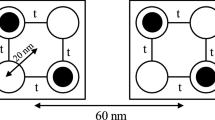Abstract
We present an ab initio quantum chemistry study of {(η5-C5H5)Fe(η5-C5H4)}4(η4-C4)Co(η5-C5H5)2+, a molecular candidate for quantum-dot cellular automata (QCA) which has been synthesized and characterized recently. Our studies support the experimental interpretation that this molecule has a bistable electronic state, and that binary information can be encoded in the molecular charge configuration. We show that when molecules are properly arranged, one molecule can be switched by the Coulomb interaction produced by a neighboring molecule. Our studies also show this molecule is error-tolerant when the four-fold symmetry is broken by a C–C single-bond distortion.
Similar content being viewed by others
References
1. C.S. Lent and P.D, Tougaw, “A Device Architecture for Computing with Quantum Dots,” Proceed. of the IEEE, 85, 541 (1997).
2. A.O. Orlov, et al., “Realization of a Functional Cell for Quantum-Dot Cellular Automata,” Science, 277, 928 (1997).
3. I. Amlani, et al., “Digital Logic Gate Using Quantum-Dot Cellular Automata,“ Science, 284, 289 (1999).
4. J. Jiao, et al., “Building Blocks of the Molecular Expression of Quantum Cellular Automata. Isolation and Characterization of a Covalently Bonded Square Array of Two Ferrocenium and Two Ferrocene Complexes,” J. Am. Chem. Soc., ”125, 7522 (2003).
5. C.S. Lent, “Bypassing the Transistor,” Science, ”288, 1597 (2000).
6. M.J. Frisch, G.W. Trucks, H.B. Schlegel, G.E. Scuseria, M.A. Robb, J.R. Cheeseman, V.G. Zakrzewski, J.A. Montgomery, R.E. Stratmann, J.C. Burant, S. Dapprich, J.M. Milliam, A.D. Daniels, K.N. Kudin, M.C. Strain, O. Farkas, J. Tomasi, V. Barone, M. Cossi, R. Cammi, B. Mennucci, C. Pomelli, C. Adamo, S. Clifford, J. Ochterski, G.A. Petersson, P.Y. Ayala, Q. Cui, K. Morokuma, D.K. Malick, A.D. Rabuck, K. Raghavachari, J.B. Foresman, J. Cioslowski, J.V. Ortiz, B.B. Stefanov, G. Liu, A. Liashenko, P. Piskorz, I. Komaromi, R. Gomberts, R.L. Martin, D.J. Fox, T.A. Keith, M.A. Al-Laham, C.Y. Peng, A. Nanayakkara, C. Gonzalez, M. Challacombe, P.M.W. Gill, B.G. Johnson, W. Chen, M.W. Wong, J.L. Andres, M. Head-Gordon, E.S. Replogle and J.A. Pople, Gaussian 98, (Gaussian Inc. Pittsburgh, PA, 2001).
Author information
Authors and Affiliations
Rights and permissions
About this article
Cite this article
Lu, Y., Lent, C.S. Theoretical Study of Molecular Quantum-Dot Cellular Automata. J Comput Electron 4, 115–118 (2005). https://doi.org/10.1007/s10825-005-7120-y
Issue Date:
DOI: https://doi.org/10.1007/s10825-005-7120-y




